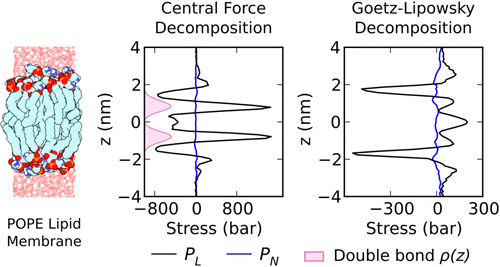Juan M. Vanegas, Alejandro Torres-Sánchez, Marino Arroyo. Journal of Chemical Theory and Computation 10 (2) 691-702 (2014).
Local stress fields are routinely computed from molecular dynamics trajectories to understand the structure and mechanical properties of lipid bilayers. These calculations can be systematically understood with the Irving–Kirkwood–Noll theory. In identifying the stress tensor, a crucial step is the decomposition of the forces on the particles into pairwise contributions. However, such a decomposition is not unique in general, leading to an ambiguity in the definition of the stress tensor, particularly for multibody potentials. Furthermore, a theoretical treatment of constraints in local stress calculations has been lacking. Here, we present a new implementation of local stress calculations that systematically treats constraints and considers a privileged decomposition, the central force decomposition, that leads to a symmetric stress tensor by construction. We focus on biomembranes, although the methodology presented here is widely applicable. Our results show that some unphysical behavior obtained with previous implementations (e.g. nonconstant normal stress profiles along an isotropic bilayer in equilibrium) is a consequence of an improper treatment of constraints. Furthermore, other valid force decompositions produce significantly different stress profiles, particularly in the presence of dihedral potentials. Our methodology reveals the striking effect of unsaturations on the bilayer mechanics, missed by previous stress calculation implementations.
